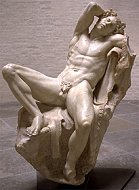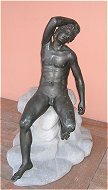Sleeping FaunMuseum Label: Chiurazzi description: Origin: Museo di Napoli Read more about Saryrs and Fauns here. A new window will open. Close after reading to come back here. |
||
 |
Subject info: The Ringling Museum sculpture is probably based on an interpretation of the Barberini Sleeping Faun (see pic on the left). The life-size marble statue, known as the Barberini Faun or Drunken Satyr, is located in the Glyptothek in Munich, Germany. The sculpture was discovered in the early 1600s at the Castel S. Angelo and was kept in the Palazzo Barberini. The right leg and hanging left arm were missing and have been added (in plaster) in 1679 and replaced in marble in 1738 and an elaborate support of tree branches, which enabled it to sit again. From then on different positions and shapes for the legs and base were added and remodeled again and again. |
After many negotiations the sculpture was bought by Prince Ludwig of Bavaria and installed in the Glyptothek in 1827.
The marble sculpture is thought to be a replica of a Pergamene bronze by an unknown
Hellenistic sculptor, in the late third or early second century BCE. The statue was found
in the 1620s at the Castel Sant Angelo, Rome, which in Antiquity had been Hadrian’s
Mausoleum. Work on the fortification was undertaken by the Barberini Pope Urban VIII in
1624. The sculpture made its first documented appearance in a receipt for its restoration,
6 June 1628, when it already belonged to Cardinal Francesco Barberini. When discovered,
the statue was heavily damaged; the right leg, parts of both hands, and parts of the head
were missing. The historian Procopius recorded that during the siege of Rome in 537 the
defenders had hurled down upon the Goths the statues adorning Hadrian's Mausoleum, and
Johann Winckelmann speculated that the place of discovery and the statue's condition
suggested that it had been such a projectile.
It was traditionally asserted that Cardinal Maffeo Barberini commissioned Gianlorenzo
Bernini to restore the statue, "but there is no evidence for the tradition that
Bernini was in any way involved with the stature," Francis Haskell and Nicholas Penny
oberved in 1981, after reviewing the documentation and literature. Restorations, at first
in stucco, were remade in 1679 by Giuseppe Giorgetti and Lorenzo Ottoni, who enabled the
antique left leg to be reaffixed and provided the elaborate supporting structure that is
illustrated in Paolo Alessandro Maffei's Raccolta di statue (1704); in the eighteenth
century the right leg was again restored in marble, and once more by Pacetti in 1799. (The
sculpture is shown today without the restored hanging left arm.)
These restorations of the Barberini Faun may have enhanced the sexual aspect of the
statue. Because of this, the statue has acquired a reputation as an example of homoerotic
art. Nudity in Greek art was nothing new, however the blatant sexuality of this piece
makes it the most interesting to twentieth-century eyes. His wantonly spread legs focus
attention on his genitals: Maureen Dowd, a New York Times columnist, compared the nude
photographs of Jeff Gannon he advertised on the Internet to the Barberini Faun.[6] Not all
viewers have found the Faun so indecorous: the Barberini Faun was reproduced on a
Nymphenburg porcelain service in the 1830s.
http://en.wikipedia.org/wiki/Barberini_Faun
